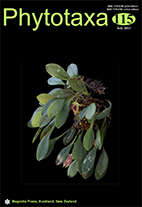Abstract
The DNA barcode approach is using a short genetic marker for rapid identification of a particular species. The internal transcribed spacer (ITS) region has been chosen as barcode marker for fungi. Here we tested the potential of ITS to identify distinct lineages in the Cladia aggregata complex, a group of lichenized fungi exhibiting remarkable morphological and chemical diversity. Our recent studies using multilocus DNA sequence data and coalescent-based species delimitation methods supported a 12 species delimitation scenario. In this study, we evaluated the ratio of the intra- and interspecific genetic distances of ITS in these 12 putative species. All 12 putative species showed a lower ratio of intraspecific variation than interspecific variation, supporting the hypothesis that these represent distinct lineages. Consequently, these lineages are here accepted at species level and three new species, viz. Cladia blanchonii Parnmen & Lumbsch, C. cryptica Parnmen & Lumbsch and C. tasmanica Parnmen & Lumbsch are described and the new combinations Cladia gorgonea (Eschw.) Parnmen & Lumbsch, C. neocaledonica (Räs.) Parnmen & Lumbsch, and C. terebrata (Laurer) Parnmen & Lumbsch proposed.

